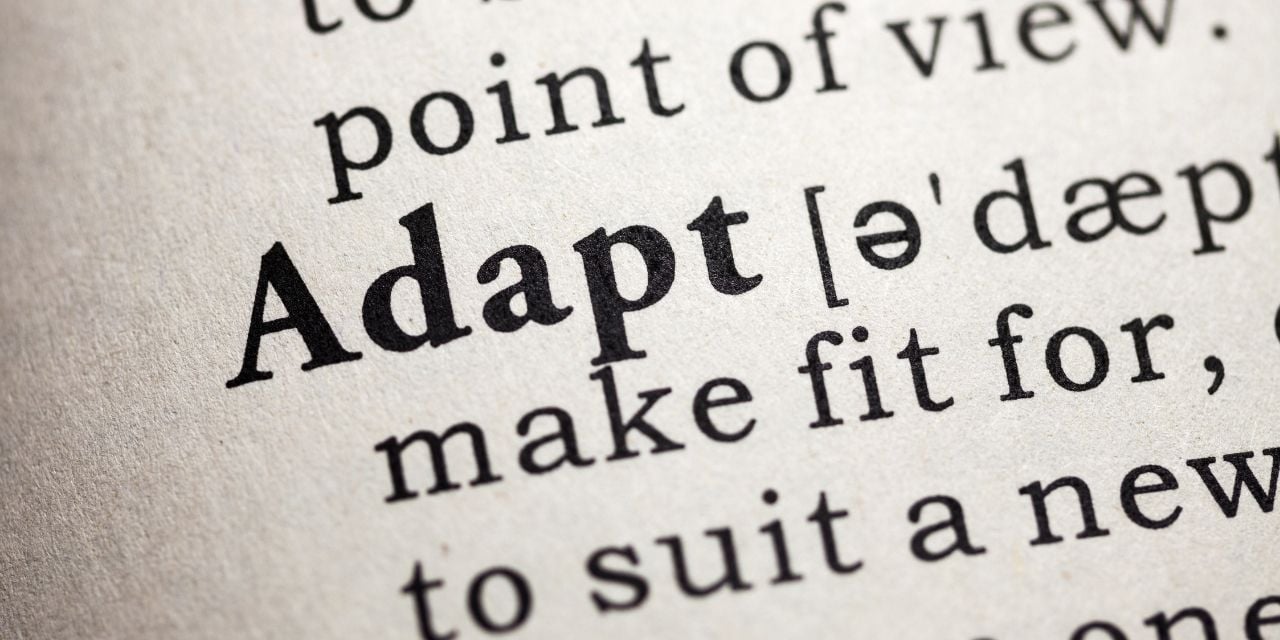13 Minutes of reading
What is adaptive learning?
Adaptive learning is now present in more businesses than ever before. It’s easy to see why its popularity has grown: organisations are looking to optimise their training programmes and to help their staff gain new skills more quickly. Adaptive learning fits the bill perfectly, using artificial intelligence to provide personalised courses for each employee.
The future looks bright for adaptive learning, but with turbulent economic conditions and a job market in flux, there are also plenty of challenges for it to meet. Here, the Rise Up team will go into more detail about what adaptive learning is and examine whether it’s a good fit for today’s workplaces.
Defining adaptive learning
Adaptive learning: at the intersection of neuroscience, big data and artificial intelligence
Adaptive learning is an approach to education that is focused on the individual. Instead of offering the same course to all members of a given group, educational content is tailored to best suit each learner. Within a business context, this means providing employees with only the training that will actually be useful to them.
It is possible to apply adaptive learning in different ways within a training programme. You choose to customise on the following levels:
- Course-wide — the modules offered to each learner and the order in which they appear
- Content — the topics covered and skills taught during the course
- Teaching methods — the way in which information is presented
When you introduce adaptive learning into your training programme, you can ensure that your employees can benefit from each of these three types of personalisation. As they progress through their course, the modules they see will adapt to meet their abilities, needs, expectations and preferences.

You might think that adaptive learning is a one-time process. However, the really clever thing about it is that it is able to continuously refine the content, modules and learning styles offered to each employee as it gains more information about them. As their needs change, so too does their training course.
Achieving such a high degree of personalisation is, of course, no mean feat. To work effectively, adaptive learning algorithms rely on a combination of these three key elements:
- Neuroscience, which enables us to understand the human brain and the ways in which we take in new information and gain skills
- Data collected about each learner, both before they begin their training and as they complete their course
- Machine learning, a form of artificial intelligence that is able to automatically interpret and analyse large volumes of data and use this information to make predictions about each learner — in this context, it can be more specifically referred to as adaptive machine learning
Thanks to these tools, adaptive learning systems are able to recommend the right modules for each individual in real time. More data is collected about the learners every step of the way, and this goes on to further inform the relevant algorithms, thus improving future recommendations. A low score in an assessment, for example, may prompt the system to offer the learner a revision module so that they can brush up on that skill.
Distinguishing macro from micro
Training courses can be personalised in a variety of different ways. One of the most important distinctions concerns macro and micro forms of adaptive learning.
Macro adaptive learning
First, we’ll look at macro adaptive learning. This approach concerns personalisation that takes place at the course level. Instead of every learner going through their training programme in the same way, they are instead offered modules in different orders, based on their results and how quickly they are picking up the given skill. Revision modules may also appear as necessary if learners’ knowledge is weaker in a particular area.
With macro adaptive learning, therefore, the structure of the course varies, and employees are free to learn at a pace that suits them. However, everyone will ultimately cover the same set of content.
This is a good approach to choose if your aim is to help all learners reach the same level of proficiency, and is suitable for longer, more content-heavy courses. An example of this would be if your team all needed to reach a certain level of proficiency in a foreign language. Through macro adaptive learning, everyone would gain the same abilities, but would get to this point at different speeds and by following their own pathways.
Micro adaptive learning
Our next approach is micro adaptive learning, and here, instead of merely changing the order, the actual content covered changes from learner to learner. Each user will gain different skills, take different modules and assessments, and so on. Employees’ preferences in terms of learning style will be taken into account, in addition to data regarding their progress and how easily they pick up knowledge. This allows for a much greater degree of personalisation.
With micro adaptive learning, employees need not waste time on modules that are irrelevant to their job role, and can instead focus their attention on gaining skills that will be most useful to them. This helps businesses to stay agile in a demanding environment. This approach is suitable for use when you need members of staff to gain a specific skill in a shorter time frame.
Pros and cons of adaptive learning
Benefits
It’s not difficult to see some of the major benefits of adaptive learning—particularly for businesses. Each organisation will have staff working in vastly different positions and departments, and each employee will have their own existing skills, goals and abilities. Traditional, standardised forms of training do a bad job of catering to this need, while adaptive learning excels at it.
Adaptive learning allows employees to gain the skills they truly need for job success, as well as empowering them to learn in the ways that suit them best. They also benefit by no longer having to cover content that they already know or which will not enhance their performance. This reduces wasted time and improves the overall quality of training.
In a similar vein, adaptive learning is helping businesses to reshape training programmes for the better. With learners now able to access the most appropriate teaching methods and content formats for them, they’re more likely to engage with their training materials. In turn, they’re likely to gain skills more quickly, thus helping to achieve both business and personal goals.
Not only do learners acquire knowledge more easily thanks to this approach, but they also retain it more effectively. That’s because adaptive learning systems come with built-in tools aimed specifically at helping to cement skills, such as quizzes offered days, weeks or months after the completion of a module. There’s even a virtual coach on hand to offer tutoring to learners as and when they need it—but more on that later. Finally, all of these benefits can be reaped without training admins having to lift a finger. That’s a huge time saving for you!

Drawbacks
The main criticism levelled against adaptive learning is that it fails to take into account the importance of human interaction. By automating the learning process, the role of trainers can be minimised and personal connection can be lost.
Given that the way we learn is heavily influenced by factors such as our emotions and the bonds we share with others, this is a weakness that needs to be addressed. A good solution is not to rely solely on adaptive learning, but instead to integrate it into a broader approach to training that encompasses other formats and teaching methods. We’ll cover this in more detail shortly.
Aside from this problem, another disadvantage is that adaptive learning software can be difficult to pick up due to the advanced technologies used. Stakeholders must also be equipped with the analytical skills required to interpret the results of any training programmes. With large amounts of data to handle, much of which may be difficult to interpret, this can be a tall order.
The final issue is the inconsistent quality of adaptive learning software on the market. While some solutions come with a wide variety of useful features, other tools may be found wanting. Any business looking to invest in an adaptive learning platform should do their research in advance to make sure they’re getting the functionality they need.
How does adaptive learning work on an LMS platform?
Many LMS platforms, including Rise Up, offer features that can help to make adaptive learning systems even more effective. We’ll run through some of them below.
Support and tutoring
Any truly great adaptive learning software will place a strong emphasis on providing each employee with the support they need. The Rise Up platform, for example, offers messaging, discussion forums, and even a virtual coach that offers learners various forms of help throughout their course, including:
- Training suggestions
- Content recommendations
- Reminders and notifications, both via the LMS platform and apps such as Teams, Slack, and the company intranet
Competency frameworks
To be able to recommend relevant training courses to the correct employees, a competency framework is indispensable. This is a document that details the skills that your business needs in order to function at its best and to meet any future goals. It also helps you to perform skill gap analysis: working out which competencies are already present in your business, and which need to be acquired via training.
Competency frameworks are created collaboratively by trainers, managers, HR personnel, and other relevant stakeholders. Having such a document in place makes it simpler to set up your training courses with adaptive learning. You can even do this directly using an LMS—all you need to do is organise the skills listed in the framework into different categories, then match them up to a given course.
With all of this in place, employees can easily find the training material that matches their department or position. For example, if you categorise a particular course under ‘marketing’, then it will be automatically offered to the relevant employees in your marketing department. Simple!
Question banks
Alongside your competency framework, a useful tool to help you roll out your adaptive learning course is a question bank. This is a collection of questions created by a training content manager, who can then use an LMS to link them to a given skill.
With a question bank in place, carrying out assessments is easy. All that a trainer needs to do is specify the skills they want to examine and the number of questions to be included. The platform can then select an appropriate set of questions from the bank automatically and at random.
During a training course, question banks are a great way of determining whether employees have reached the required level of competency in the relevant skills. It’s also useful for examining each learner’s existing knowledge base prior to the beginning of the course, as it allows for the creation of placement tests. If an employee fails this test, then trainers can adapt content to boost their understanding and meet their needs.
How can you incorporate adaptive learning into a wider digital learning strategy?
Despite its benefits, we’ve already seen that adaptive learning comes with some limitations, particularly when it comes to human interaction. Additionally, training is more effective when learners have access to a variety of different learning formats and teaching methods. So, how can you address these challenges all while harnessing the potential of adaptive learning? The best option is to include adaptive learning as one part of a digital learning strategy.
For the best possible results, training should include both in-person and remote sessions. Likewise, e-learning modules should be complemented with virtual classes, and a mix of adaptive learning, mobile learning and social learning should all be used.
When creating your adaptive learning path, it’s important to use each of these learning methods when they will be most effective. Adaptive learning, for example, is best used for knowledge-based and functional purposes (‘hard skills’). This may include learning how to use a certain piece of software or building your vocabulary in a new language.
However, when it comes to ‘soft skills’, which focus on interpersonal relationships, adaptive learning has limited use. This is where face-to-face sessions make a bigger impact; indeed, they can help employees to manage stress, increase their self-confidence and put their emotional intelligence to good use.
Adaptive learning can, nonetheless, come in handy at multiple stages of the training process. Within a blended learning strategy, adaptive learning can be used to:
- Carry out pre-course and placement tests
- Plan out training courses
- Offer personalised content
- Conduct final assessments
- Regularly refresh learners’ knowledge via revision materials
Challenges for adaptive learning in 2022
Businesses know that, to remain competitive and boost their performance, they need to have the right set of skills in house. As markets become ever more unpredictable, the importance of the role played by professional training is coming sharply into focus. More specifically, today’s environment raises important issues for adaptive learning to address in 2022.

One such challenge concerns dealing with the sudden, meteoric rise of digital learning in the wake of the COVID-19 pandemic. With working patterns seeming to have permanently changed, new training processes are needed—and adaptive learning has a big role to play in them. Personalisation is putting learners at the heart of their own training courses, improving their experience and helping to make blended learning strategies more effective.
Meanwhile, as hybrid working becomes the norm, it’s become increasingly important for businesses to include both in-person and remote aspects in their training strategies. Additionally, there’s a recognition of the need to use varied learning formats to boost engagement and motivation levels—as well as an impetus to go beyond simply building new skills and instead to focus on promoting better employee wellbeing.
As discussed above, a skills-based approach to training is a necessity in 2022, and adaptive learning is an important tool to have in order to meet this need. It plays a key role in tackling a range of challenges, from addressing the skills gap within your organisation through to optimising the training process.
Finally, recent years have highlighted the importance of developing a culture of learning within businesses. It’s no longer enough to merely provide traditional training. Instead, you need to give employees the chance to share their expertise, encourage people to learn from one another, and build training into the working routine instead of viewing it as a distraction. In short, we need an overhaul in the way we think about training.
Is adaptive learning the future of professional training?
With adaptive learning technologies having come on in leaps and bounds, many companies are beginning to dream of a future where their skill requirements are addressed near-instantaneously. After all, adaptive learning does a great job of meeting employee needs and expectations, helping them to hit their targets and develop professionally. Add in faster learning times and higher motivation levels, and what’s not to like?
In this regard, adaptive learning is the future of training—but only one aspect of it.
The reality is that a much greater shift needs to take place in many businesses regarding the way that training is both perceived and delivered. Not everyone is striking the right balance between personalisation and team cohesion when planning out their courses. Total reliance on adaptive learning, for example, risks neglecting the personal side of training. Meanwhile, the software available on the market varies tremendously in quality—and companies often fail to take full advantage of the tools they do have.
All of this leads us to one simple conclusion: the future of training will include adaptive learning, but it needs to be much broader in order to truly help businesses succeed. The way forward is blended learning—and the best part is that you can take advantage of this right away. With Rise Up, the future of training is in your hands today.



